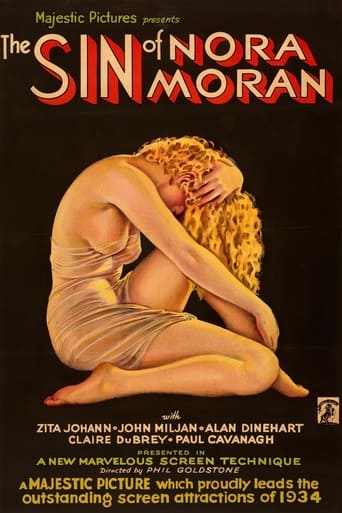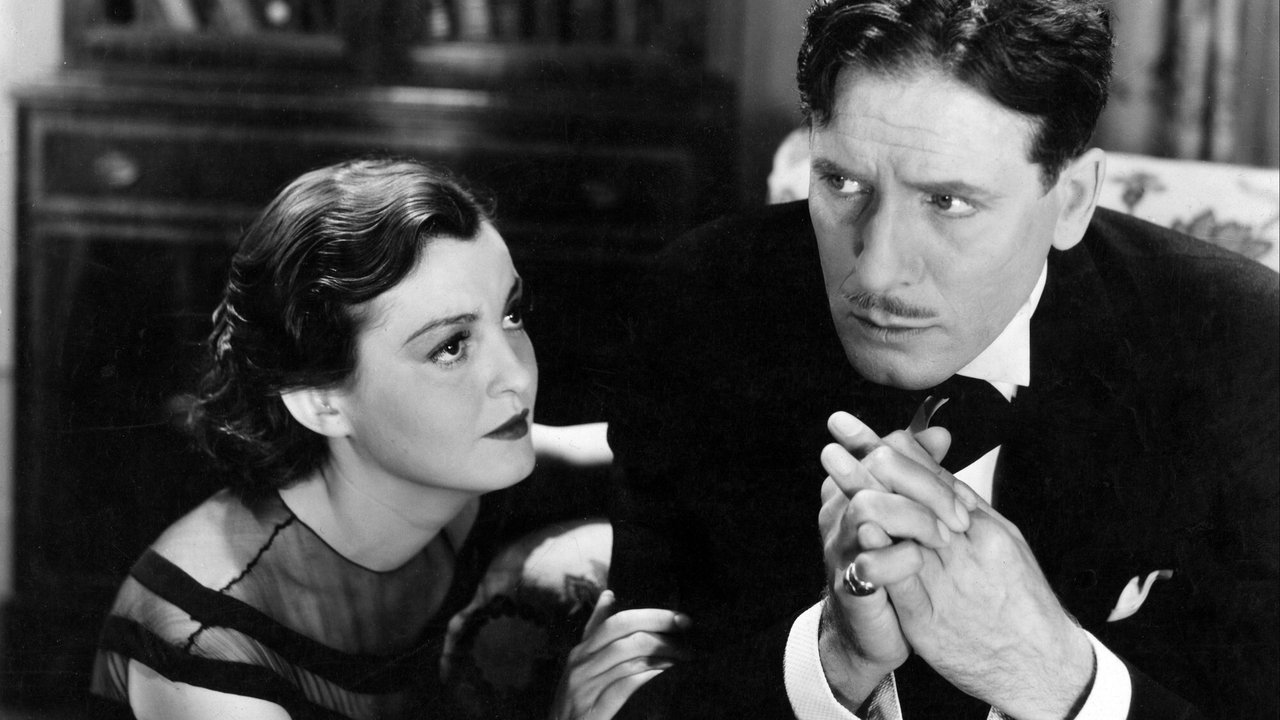Richard Chatten
Although this film plainly avails itself of the relaxed censorship available to pre-Code Hollywood, it's quite unlike anything else from that era; its most obvious pre-Code hallmark being the astonishing amount it manages to pack into just over an hour's running time. Long before the end, your head is spinning from the film's unending assault on your senses; and critics at the time just didn't get it (not helped by the catchpenny title derived from 'The Sin of Madelon Claudet', for which Helen Hayes had recently received an Oscar). Mordaunt Hall of 'The New York Times', for one, dismissed it simply as "all very muddled and parts of it are apt to be exceedingly depressing." He also claimed that it "strives to emulate the "narratage" story treatment as it was done in 'The Power and the Glory'". Since production of 'The Sin of Nora Moran' wrapped at the end of June 1933 while William K. Howard's 'The Power of the Glory' (often stated to have inspired the non-linear structure of 'Citizen Kane') opened in August, this has to have been simple coincidence; and 'The Sin of Nora Moran' goes way, way beyond Howard's more celebrated film in its use of the form. To Hall, 'Nora Moran' was just "a bewildering mass of scenes", but seen today it's perfectly easy to follow; you just never know what new technical flourish the extraordinary hybrid of narrative and visual elements past, present and future this film is going to next throw in your face.Polish-born independent producer-director Phil Goldstone (1893-1963) was a silent film veteran and former president of Tiffany Pictures who had recently acquired the poverty row outfit Majestic Pictures with the intention of upgrading its product. 'The Sin of Nora Moran' was the first of only two talkies he directed (the other being a 1937 version of that old exploitation warhorse, Eugène Brieux's 'Damaged Goods'); which makes his mastery of the new medium all the more remarkable, aided by Ira Morgan's Germanic photography and editing by Otis Garrett (later a director himself) that makes Eisenstein look like Mizoguchi. (An uncredited Heinz Roemheld contributes an energetic score that never lets up for a moment; adding to the film's continental feel.) The film completed, Goldstone continued to demonstrate his commitment to this labour of love by commissioning a sophisticated poster from Alberto Vargas that is better known today than the film itself.The most surprising thing about this film is that it's not a remake of a European original; since it certainly feels like one. It was actually based on a play by newspaperman Willis Maxwell Goodhue (who died in 1938) originally titled 'Burnt Offering'; and as befits the title, the script at one point goes into remarkably graphic detail about the process of execution in the electric chair. Nora is injected with an "opiate" (the word used) to prepare her for the end; which paves the way for the hallucinatory stream of consciousness that follows. Sometimes it feels like a German silent kammerspielfilm, at others like forties 'film noir' and still others like a wide range of art cinema yet to come (including late Dreyer and early Bergman, Resnais and Oshima). The nearest equivalent I've hitherto come across to the remarkable associational non-linear structure of this film - constantly jumping between times, places and viewpoints - is in another neglected masterpiece (from Japan of all places!) Keisuke Kinoshita's 'Snow Flurry' (1959).Dark-eyed Zita Johann, whose short-lived film career was nearing its end when she made this film, looks haunted as only she could in the demanding title role; while Alan Dinehart is given rather more to get his teeth into, and a somewhat more nuanced characterisation than he was usually accustomed to.Highly recommended.
JohnHowardReid
Based on a stage play entitled "Burnt Offering" by newspaperman turned press agent (for Webber and Fields, Chauncey Olcott and many others), W. Maxwell Goodhue, this is, to say the least, an amazing film noir. Its complex narrative structure anticipates many of the famous classics including Citizen Kane. Nor is the direction by Phil Goldstone (a "B" movie producer who directed only two sound movies of which this is the first) in any way lacking. In fact, it's very inventive, as is the darkly noirish cinematography of Ira H. Morgan (who co-photographed the fabulously spectacular "When Knighthood Was in Flower" in 1922 but whose career declined in the sound period where, except for an occasional "A" like Chaplin's Modern Times, he worked almost exclusively in Poverty Row. He managed to chalk up over 200 credits in all before his death in 1979). The acting too is highly creditable, particularly by Zita Johann in the title role, John Miljan as one of the most repulsive villains ever seen in a movie, Claire Du Brey as the self-centered, antagonistic Mrs. Crawford, and Paul Cavanaugh as the charming but disappointingly weak-willed governor. The only not-so-hot performance is offered by the normally thoroughly professional Alan Dinehart who seems unsure how to play his role. As a result, he simply rattles off his lines and is often unconvincing. In all, however, The Sin of Nora Moran is a must-see item for every film noir fan. Available on an excellent Alpha DVD.
kidboots
Adapted from the play "Burnt Offerings", it was originally produced under the title "The Woman in the Chair" and in the 1980s it was re-released as "Voice From the Grave". Whatever the title it was an extraordinarily strange little film using a stream of consciousness narrative (used the same year by Preston Sturges in "The Power and the Glory") and according to some critics, maybe the best independent feature of the thirties. It definitely would have confused a lot of viewers of the day but as a Majestic release it would have played on the bottom half of double bills, so it may have been a pleasant surprise or a confusing one.Edith Crawford (Claire DuBrey, who played the first Mrs. Rochester in the 1934 version of "Jane Eyre") visits her brother, a District Attorney (Alan Dinehart), determined to find out who her husband, Bill, is having an affair with. The "other woman" is Nora Moran (Zita Johann)who is about to be executed for murder. There is a very confronting scene involving preparations before an execution and then Nora's subconscious mind takes over. After a rather sad childhood, Nora finds herself working in a circus for Paulino (John Miljan), a lecherous lion tamer who rapes her. A year later Nora feels she has found happiness with Bill but Paulino comes back on the scene, hoping to try some blackmail and is killed.There is much "avant garde" film-making in this. Apart from SOC, there are flashbacks within flashbacks (similar to the 1940's movie "The Locket"), eerie appearances - Sarah Padden, as one of Nora's circus friends, suddenly materializes beside her prison bed, as does Nora, who appears to Bill (Paul Cavanaugh), to plead with him not to let her die in vain. (He is really a weak person and Nora begs him to try to be strong for her sake). There is even a bizarre fantasy sequence in which the men in her life discuss events standing around her coffin!!! It is a very strange movie!!Alan Dinehart seems to be the only actor in the movie that you can warm to. He is not particularly a "good guy" but has a dimension to his acting that the other players lack. Zita Johann a stage actress, who D.W. Griffith selected for the female lead in his film "The Struggle", had the intensity but no heart. You somehow can't imagine her as a chorus girl - Mae Clarke would have been perfect, but that is just my opinion. Cora Sue Collins was a child star who seemed to get some plum roles (until Shirley Temple came along) - she had played Greta Garbo as a child in "Queen Christina". She was top billed in a part that only lasted 60 seconds at the most. Henry B. Walthall, was also in the cast as the kindly Father Ryan, who looked after Nora as a child.Recommended.
ptb-8
MAJESTIC PICTURES in their short Hollywood production life 1930-35 made excellent small films using sets at other studios. This meant they could use those facilities and instead spend big on actors and crew. Without studio overheads their input concentrated on finding and using excellent A grade sets and costumes and facilities without owning them. As a result their films had an RKO or MGM look. Actors would be called to make a film at RKO and find it a Majestic title ensuring constant work on a big lot but maybe for a minor player. This allowed Majestic to get A tech and image at a bargain rate and not embarrass their desired actors. However in this film they even excelled themselves and most Hollywood majors studio style in creating a unique melancholy almost- noir nightmare of doomed love and honor... and all the emotional treachery that goes with it. Somewhere between SORRY WRONG NUMBER and DETOUR and overlapping time shift of PULP FICTION, this film THE SIN OF NORA MORAN uses those techniques and techniques of voice over, flashback and sad romance with equal parts hangman's noose, resigned fate and deceit. What a find! THE SIN OF NORA MORAN is a film school textbook of economic film making and could easily stand an upgraded remake today. Excellent! Treat yourself!. Good restored UCLA DVD too. Zita Johan in the lead part as Nora is simply exquisite and her melancholy tone throughout is most effective. Her sin? Being born.


 AD
AD
